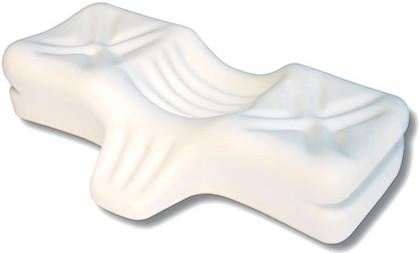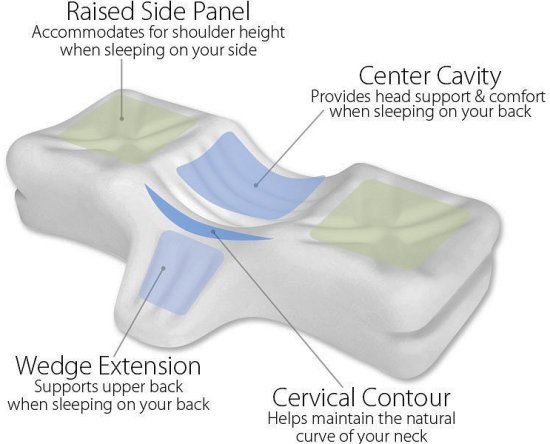Cervical Pillows Help Relieve Neck Pain & More
Symptoms related to the cervical spine, such as neck pain, muscle stiffness, headaches and shoulder pain. Using cervical pillows can have a significant affect. Often, people will choose bad pillows, resulting in poor sleeping quality, uncomfortable positioning and discomfort in the morning.
Frequently, advice is sought from a heath professional for recommendations in selecting good pillows. Generally, pillows that keep the cervical spine in neutral postures help to prevent these problems, through a preventing stress of spinal segments. Research is still in the process of determining how the cervical spine reacts to specific pillows.
Cervical Pillows & Sleeping Positions
Side sleeping is most commonly used by adults and pillows supporting the cervical spine provide stabilization as both the pillow and mattress compress in responding to body weight and spinal tissue settling takes place, usually requiring about ten minutes.
Using properly supportive pillows, along with a body pillow, in a side sleeping semi-fetal position can help keep the cervical and the rest of the spine from twisting or placing torque on the neck and back.
Some prefer to sleep on the stomach, however, this places a great deal of torque on the cervical spine, especially with high pillows or using 2 pillows. Using a pillow with appropriate support and a body pillow designed to help transition to side sleeping can provide a great solution.
Improper pillows resulting in poor neck posture as well as lack of cervical support may cause one to wake with neck pain, muscular stiffness of the neck and shoulders, poor blood circulation resulting in arm or hand tingling/numbness and headaches.
Neck related headaches may result from pain referred from the upper cervical spine. Shoulder and arm pain may result from pain referred from the lower cervical spine. If you wake up with these symptoms and they were not there when you went to sleep at night, or if these symptoms are more painful in the morning, you may benefit from using cervical pillows as well as better posture during sleep.
As we as age, there is an increase in side sleeping positions, with a reduction of changing positions when sleeping, along with an increase of sleeping in a single position lasting between 1 and 2 hours. In general, adults will change positions 11 – 13 times on a single night.
Some factors which may affect frequency of changing sleeping positions are; an illness like sleep apnea, caffeinated beverages and/or large meals can cause an increase in the frequency of sleeping movements, alcoholic beverages can decrease sleeping motions early on, while increasing movements later in the night.
A lack of comfort, possibly due to a poor mattress, being too cold or too hot, being in strange or noisy environments, stress and anxiety as well as having a partner that is not comfortable or can’t get settled can further affect frequency of sleeping movements.
Neck pain along with stiffness is common and increasing. Chronic neck pain is associated with tension headaches related to subconscious muscle tension.
Often, sleeping with neck pain can be difficult and it becomes troublesome finding a good neck position for the neck. There is an association between pain and sleep quality.
Types Of Pillows
There are many types of cervical designed pillows to assist in alleviation of neck strain, creating a better sleeping position. The design of these pillows are is intended to provide relaxation as well as maintaining a natural, healthy cervical posture. Many suggest these for whiplash recovery and cervical spondylosis or degenerative disc disease. They may also benefit those with neck muscle strain.
Cervical pillows are are also used for prevention of neck pain. In a health conscious society, many realize the importance in getting proper sleep. In testing pillows, there have been positive results noted regarding on neck pain, headaches as well as sleeping quality.
Those using memory foam function to follow the contours of the anatomical neck curve. The softness and warmth can provide comforting relief associated with acute neck conditions such as a recent injury or a chronic neck problem associated with degenerative conditions. Other pillows which can provide relief for these conditions are reactive pillows like the water filled pillow or inflatable pillow. Under these circumstances, firm pillows may prove to be excessively irritating for sensitive neck muscles.
Firmer pillows can be gradually worked up to as a condition improves or, if you do not have a particularly painful neck problem, a firm pillow may help prevent neck conditions from arising and maintain the proper cervical curve. Additionally, those with fibromyalgia sometimes show a preference for a firmer pillow for neck pain relief and improving sleeping quality.
Memory foam pillows use either a cut, open cell foam or a molded closed cell foam. Molded ones have a kind of skin over them. While this may increase pillow life, it causes the pillow to retain more heat and be more bouncy. Open cell memory foam like the type used in the posture med or future foam pillows tend to have less harsh chemicals, breathe better, retain less heat and are more comforting.
A neck roll cervical pillow may be beneficial for chronic neck pain and the larger, softer neck rolls may be appropriate for sleeping, while smaller ones, or a rolled up towel, can be placed inside the pillowcase at the bottom to create your own cervical pillow. A neck roll using memory foam can provide a therapeutic benefit, especially those designed to use a hot/cold pack to ease pain and relax muscles.
So, how is your pillow? Too hard or soft? Is it bouncy? Does it make too much noise or make you sweat? Is the shape not right? Does it put too much stress in your neck? Is the height too
low or too flat?
If you are not comfortable because your pillow is too flat, you can fold a towel and put it underneath your pillow, allowing the height of the pillow to increase. Take approximately 10 or 15 minutes for your neck to relax. If this makes a difference, you should get a pillow that has a greater height. If you feel your pillow is too high, you can sleep on the folded towel only.
It takes about one week of sleeping on a new pillow to determine if it will help. A nice way to minimize the disappointment of being stuck with a pillow is to have an adjustable on like the inflatable pillow or a water pillow. This way, you can change the height if needed without changing pillows. Some like the therapeutic pillow, you can measure for correct fit. Cervical pillows that use separate sections for back and side sleeping provide correct posture in either position are called functional pillows, however, you need to be able to change positions consciously so you do not wake up on the wrong side and aggravate your neck.
A 2014 study on improving the quality of sleep with an optimal pillow indicated an orthopedic pillow plays a crucial role the mechanics of the cervical curve, relieves pain, improves comfort and sleep quality.
Still not sure? Choosing the Best Pillow For Neck Pain, How To Choose The Right Pillow


